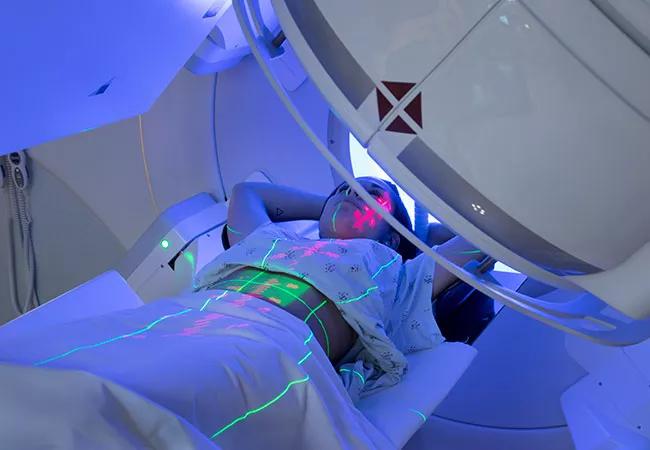Advertisement
Largest retrospective series confirms the safety and tolerability

A retrospective study of 10 heavily pretreated patients with metastatic pediatric sarcoma found stereotactic body radiation therapy (SBRT) in combination with a tyrosine kinase inhibitor (TKI), pazopanib, to be safe and well tolerated. Cleveland Clinic investigators presented the early findings of their research at the American Society for Radiation Oncology (ASTRO) 2020 Annual Meeting held virtually on October 24-28, 2020.
Advertisement
Cleveland Clinic is a non-profit academic medical center. Advertising on our site helps support our mission. We do not endorse non-Cleveland Clinic products or services. Policy
“The treatment was well tolerated in these patients, who can be pretty fragile because they have been through so much already,” says radiation oncologist and corresponding author of the study, Erin Murphy, MD. “There were no grade 3 toxicities, which means that any toxicity was manageable and that patients recovered well.”
“The treatment was non-toxic and side effects were rare,” says pediatric hematologist-oncologist Peter Anderson, MD, of Cleveland Clinic Children’s. “From a patient’s perspective, the combination of SBRT with pazopanib is not only more convenient and well tolerated, but also it helps them to get on with their life by giving us a way to effectively treat pain or prevent further growth and spread of their tumor.”
Dr. Murphy explains that radiation therapy has become far more precise over the years and that the choice of radiotherapy today largely depends on the location of metastases. SBRT delivers focused high-dose radiation in a short period of time (usually five doses of 8 Gy over the course of five days) and targets metastases directly as opposed to standard radiation, which delivers less focused, smaller doses (1.8 Gy) over the course of approximately five to six weeks.
“There are metastatic locations where SBRT could not be easily used because they are so near to critical structures, such as the esophagus or the trachea; however, for many metastatic lesions, SBRT is an underutilized tool,” she says. “Five doses [of SBRT] are as effective, perhaps more effective, than five to six weeks of radiotherapy. Knowing this, you can get control of metastases much more quickly with less toxicity and far more convenience to the patient.”
There are many benefits to this short course of intense, highly focused radiotherapy for patients, including less break from systemic therapy and less impact on quality of life. Additionally, these treatments may enhance the patients’ own anti-tumor immune response.
In light of these findings, Dr. Murphy and colleagues aimed to investigate the safety of the SBRT + pazopanib combination in a series of patients with pediatric sarcoma. They report that the safety profiles of TKIs and high-dose radiation delivered using SBRT have been established; however, less is known about the safety and tolerability of their concurrent administration.
“There’s some background data that show if you’re locally aggressive with metastases you can improve event-free survival or stop the progression of tumors. For that reason, SBRT can be an important tool in managing patients with sarcoma who have metastatic disease,” says Dr. Murphy.
Five patients with osteosarcoma, four patients with Ewing sarcoma and one patient with synovial sarcoma met inclusion criteria for the study. All 10 patients were treated with SBRT for metastases from pediatric sarcomas from 2015-2019; a median radiation dose of 3500 cGy (range 1600 – 5000) was delivered in five fractions (range 1-5). The mean patient age was 16.3 years (range 9.6 – 36.1). Treated lesions included five (38%) osseous lesions, four (31%) parenchymal (lung) lesions and four (31%) soft tissue lesions. Toxicity was assessed in patients younger than 50 who received concurrent pazopanib. Three patients experienced acute grade 1 fatigue and esophagitis, and three patients experienced acute grade 2 cough, nausea and radiation dermatitis. No grade ≥ 3 toxicities were reported.
Advertisement
Dr. Murphy adds that these findings are especially important because they confirm the tolerability of SBRT + pazopanib combination in a patient population that is at higher risk of adverse effects due to previous treatments.
“Heavily pretreated patients may not have as much bone marrow reserve, so they may not be able to recover as well from any more insults either through chemotherapy or radiation therapy,” she says. “When you are treating bone metastases with SBRT, you’re are not treating much of the normal bone marrow because you’re so focused, so any implications of radiation on bone marrow production are reduced.”
In pediatric oncology, a multidisciplinary approach to care and the support of parents/caregivers are a critical component of delivering effective treatments, Dr. Murphy says.
“Centers like the Taussig Cancer Center and Cleveland Clinic Children’s with a team approach with interventional radiologists, radiation oncologists, medical and pediatric oncologists, and surgeons who routinely work together can help patients have more options and better outcomes,” Dr. Anderson says, adding that quality of life considerations are equally important.
Advertisement
Advertisement

Polygenic risk score could help predict who will develop this aggressive breast cancer

New guidelines offer insight into emerging therapies, dental issues and more

Clinical trial to assess the value of nutritional, physical therapy and social supports prior to preoperative chemotherapy

Research demonstrates improved overall survival for patients receiving comprehensive treatment for breast cancer in addition to radiation or surgical intervention for brain cancer

Platinum-eligible phase 3 trial of enfortumab vedotin and pembrolizumab yields ‘unprecedented data’

Cleveland Clinic Cancer Institute brings multidisciplinary care, precision oncology and clinical research to the United Arab Emirates

Extent of baseline burden impacts progression-free and overall survival

Further study warranted to better understand the clinical implications of these findings